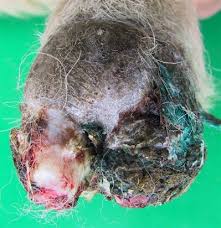Getting On Top of Contagious Ovine Digital Dermatitis
18 August 2016Many people have heard of CODD but even so misdiagnosis is still quite common, even amongst vets. Sheep can develop lesions of CODD before they become lame so regular checking of feet is essential as early interventions can be successful. CODD is caused by a spirally shaped bacterium called a trepaneme and up to 3 varieties are thought to be involved. Usually, the first sign of CODD is an ulcer or growth at the coronary band. Progression of the bacteria from here causes the hoof to separate from the underlying tissues. In advanced cases, the hoof may eventually slough off leaving a red raw and bloody digit. Up to around half of UK flocks have it.
To avoid CODD –
- Biosecurity – avoid sheep coming onto the farm due to bad fences and ensure any equipment brought onto the farm has been disinfected, CODD can survive on metal.
- Usually brought in with replacement sheep, so quarantine for a month and check them carefully during this period.
- Isolate replacement sheep in particular rams, turn them up and examine them weekly for at least a month checking the coronary band for disruption. It is better to avoid a problem in the first place than have to treat it as this is not easy. Ideally buy rams at early rams sales to improve biosecurity.
- Controlling footrot reduces the risk of sheep developing CODD, possibly because the footrot bacterium can damage the skin allowing the CODD organism to gain entry. So even using the footrot vaccine may reduce the incidence of CODD.
Treatments
Various robust treatments have been tried against CODD and you need to talk to your vet re your specific situation if you have got it. Using the antibiotic Alamycin or Terramycin in a footbath for 15 minutes resulted in half of the sheep being cured so that was not a particularly good response. Injection with long acting amoxicillin with a second shot after 3 days improves cure to 90%. Two injections of Micotil 2 weeks apart are sufficient to give a 100% cure.
Some flocks in the north of England have tried a whole flock approach using Micotil but without huge success. In a replicated trial Joe Angell, speaking at the recent SBRT, looked at 35 farms, 15 of which were randomised to get Micotil treatments at the high dose rate. Every sheep with a lesion was treated when it was detected and again later. Of the 13 treatment farms 7 did not achieve eradication, there were various reasons for this, some of it down to biosecurity, possibly on some farms the sheep were reinfected from material on the farm and there was no clinical eradication of footrot either. At a cost of £4 per ewe this approach cannot be recommended.
The best approach is to turn all ewes up, identify and segregate ewes needing treatment. Discuss appropriate products with your vet.
In long term studies there was evidence that sheep that had been cured could become reinfected but probably not on the same foot. Increasing concern about the use of antibiotics in agriculture which have human applications means their use for farm animals is increasingly likely to be stopped.
John Vipond
Sign up to the FAS newsletter
Receive updates on news, events and publications from Scotland’s Farm Advisory Service

